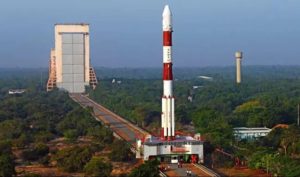
Indian Space Agency Ready To Launch PSLV-C41/IRNSS-1I Mission – See Details
New Delhi: A fortnight has not passed after ISRO (Indian Space Research Organisation) had launched home-made communications satellite GSAT-6A, the space agency is ready to launch its another independent and home-made navigation satellite IRNSS or Indian Regional Navigtion Satellite System. The launch of GSAT-6A on March 29, was an utter loss for the Space Agency, after scientists lost connection with the satellite, ISRO seems to be determined in its mission and is focusing on its latest launch – IRNSS-1I. The satellite will be launched on board the PSLV-C41 rocket. The PSLV or Polar Satellite Launch Vehicle is considered to be the most reliable and versatile workhorse for the state owned space agency and it is ready to carry the IRNSS-1l on its forty-thrid flight.

The details regarding the launch of ISRO’s PSLV-C41/IRNSS-1I are as below:
When Is The PSLV-C41/IRNSS-1I is slated to be Launched?
ISRO has set the PSLV-C41/IRNSS-1I mission launch for Thursday. The launch is going to take place at 04:04 am IST on April 12, 2018.

What Is Meant By The PSLV-C41/IRNSS-1I Launch? What Can It Do?
Polar Satellite Launch Vehicle PSLV-C41 will launch the IRNSS-1I from the first launch pad (FLP) of the Satish Dhawan Space Centre (SDSC) located at the Sriharikota High Altitude Range (SHAR) in Andhra Pradesh’s Sriharikota. The IRNSS-1I launch is going to take place in XL configuration on board the PSLV rocket. This will be the twentieth time that the PSLV’s ‘XL’ configuration will be utilized for a launch. The IRNSS-1I will be the eighth such satellite to join ISRO’s NavIC navigation satellite constellation. The 8th navigation satellite IRNSS-1I will be infact, replacement in the NavIC constellation for the 1,425kg IRNSS-1 H, whose launch was unsuccessful.
Which Were The Previous IRNSS Navigation Satellites That Have Been Launched By ISRO As Part Of The NavIC Satellite Constellation?
The previous IRNSS missions which joined ISRO’s NavIC navigation satellite constellation are IRNSS-1A (launched on July 01, 2013), IRNSS-1B (launched on April 04, 2014), IRNSS-1C (launched on October 16, 2014), IRNSS-1D (launched on March 28, 2015), IRNSS-1E (January 20, 2016), IRNSS-1F (launched on March 10, 2016), IRNSS-1G (launched on April 28, 2016), and IRNSS-1H (launched on August 31, 2017). All such launches except IRNSS-1H have been successful. Their main purpose is to build India’s self-made navigation system – similar to the US’ GPS or Global Positioning System. The orbit of some of the IRNSS satellites is placed in geo-stationary mode or GEO, while some are geo-synchronous or GSO.
What Was The Reason IRNSS-1H Satellite Launch Was Unsuccessful?
On August 31, 2017, ISRO launched the IRNSS-1H to be able to join its NavIC navigation satellite constellation. IRNSS-1H was actually planned to be launched by PSLV-C39 into a sub Geosynchronous Transfer Orbit (sub-GTO) with a 284 km perigee and 20,650 km apogee with an inclination of 19.2 degrees with respect to the equatorial plane. The lift-off of the PSLV-C39 rocket carrying the IRNSS-1H satellite was normal as per the reports, but, the mission was unsuccessful as the IRNSS-1H satellite could not be placed in accordance into the orbit properly.
You May Also Read: Bharat Bandh Goes Awry With Clashes Reported In Bihar, Section 144 Imposed In Bhopal